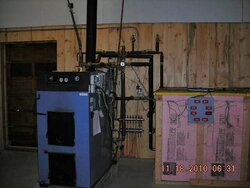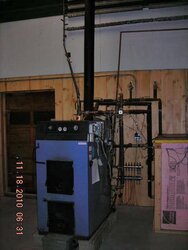I'm getting a serious disconnect in this discussion. It must be that most responders do not have free standing wood stoves in their houses for their primary heat source, and therefor regard their gasification boilers as a major fire risk, or have far fire-riskier boilers than gasification boilers, like the Tarm. I have a wood stove, and have since 1990, and essentially burn wood 24/7 during the heating season. A quick comparison between the wood stove "room," which is our living room, and the Tarm "boiler room," in my shop, shows that the Tarm boiler room is far safer and a much less fire risk than the wood stove in our living room.
Wood Stove: solid pine paneling 20" from the side of the stove and 36" from the single wall, black stove pipe.
Tarm: solid pine paneling 36"+ from the back of the Tarm and the single wall, black stove pipe.
Wood Stove: integral heat shields on back and sides, yet too hot to hold a hand against when the stove is burning.
Tarm: just warm to the touch on back and sides when the Tarm in high burn.
Wood Stove: top and front are primary heating surfaces, temperatures 600F+.
Tarm: top just warm to the touch; front, except immediately around the doors, warm to very warm; no primary heating surface.
Wood Stove: stove pipe exterior temp during normal burning 300-400F.
Tarm: stove pipe exterior temp during normal burning 175-225F.
Wood Stove: spillage of hot coals occasional when raking coals forward.
Tarm: no coal spillage, mainly because no coals, all wood burned to fine ash.
In short, I feel the Tarm is a far safer wood burning appliance than a wood stove, yet I have no qualms about using the wood stove in our house, and I have no reservation about the Tarm in the shop.



